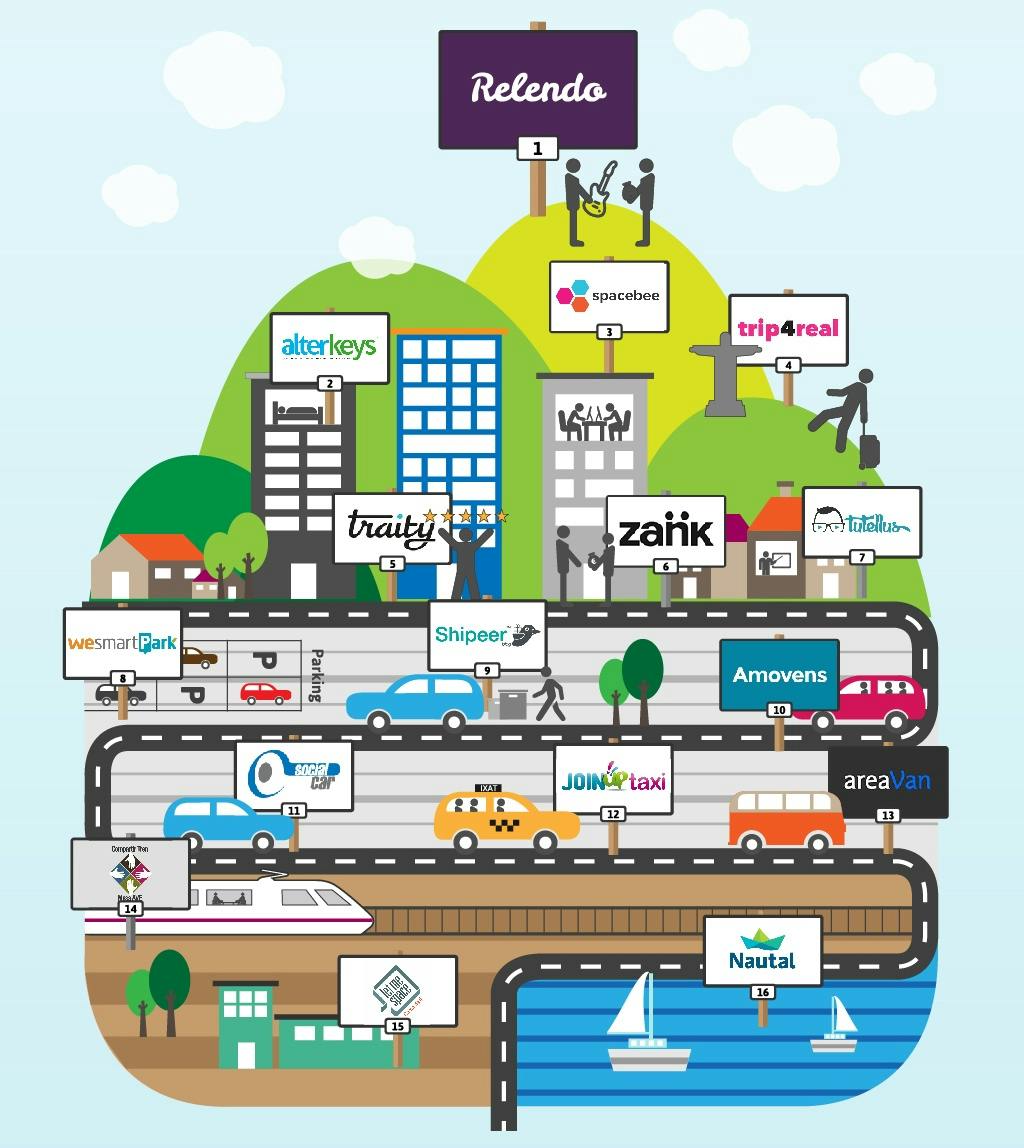How to launch your marketplace
Strategies that bring demand to your freshly opened marketplace platform.
Published on
Last updated on

This chapter of the How to create a marketplace guide helps you find your first marketplace customers and how to launch your marketplace launch. Multiple times, if necessary.
It is time to put your marketplace to its first true test: can you facilitate transactions between your customers and providers? Does your marketplace actually provide value for users?
As was stressed in the previous chapter on building your marketplace supply, you need to reach liquidity. Marketplace expert Simon Rothman puts it this way:
On the customer side, liquidity can simply be defined as the probability of finding what you are looking for. In matching supply and demand, high liquidity for customers is more important than having a huge customer base. In other words, it is better to have fewer customers who have their needs met rather than a large group who do not. Similar to when you were building supply, you should focus on quality over quantity when acquiring your first customers.
In this chapter, we are going to discuss different strategies for building your initial customer base and facilitating transactions between them and your providers.
This video is a part of our ten-step video course on building a marketplace.
While your providers should be the first ones to get access to your platform, this does not mean you shouldn't also be talking to your potential customers from the very beginning. Creating a simple email list to collect subscribers is a good idea.
This strategy worked well for the graphic design marketplace Creative Market. As co-founder Aaron Epstein explains, they set up a simple landing page to collect email addresses a few months before they actually opened up the marketplace. They even used the initial list to convince providers to join by telling them they already had lots of interested people.
How should such a list be built? Simply setting up a landing page with a signup form is not enough. To get people to actually visit the site, you need to do some initial marketing for growth. The strategies for finding your first customers are very similar to the ones for finding your first providers. You first need to understand who your potential early adopter customers are and where they hang out—both online and offline. You can then think of the best ways to reach out to them. We will cover the most common strategies here.
Your target customers may already be using a Facebook group or bulletin board to communicate. You should join the group and start participating in the discussions. Gradually, you can start mentioning your marketplace concept and asking for feedback. If you manage to attract some interest, direct them to your landing page to sign up for your email list.
For many marketplaces, university students are good initial target audiences. Student groups already have existing communication channels that you may be able to tap into. When Juho Makkonen, CEO of Sharetribe, was launching a marketplace for the students of the University of Helsinki in 2012, he contacted each student association separately and pitched them to advertise the site on their mailing lists. As a result, the marketplace got lots of initial traction, which enabled the marketplace to become liquid.
Another similar campus launch was for the Aalto University marketplace in 2009. Juho managed to make signing up to the marketplace an exercise for a computer science 101 class that was mandatory for all freshmen. This was the only marketing effort that was required to get the site going. I encourage you to try to be creative when thinking about what channels you could use—you might find some surprising opportunities.
You should also think about who the major influencers of your target customers are. Are they active bloggers? Contact them and try to make them your early ambassadors. This strategy worked well for Chicfy, a Spanish peer-to-peer marketplace that lets women buy and sell fashion. They convinced ten well-known fashion bloggers to become their first providers and advertise the site to their audiences.
In some cases, your target audience might convene offline instead of online. You need to go where the people are. Perhaps they host a monthly meetup, in which case you should attend with flyers in hand. The offline approach does not scale very well but gives you the opportunity to meet people face to face, which can turn them into dedicated supporters. As Airbnb's CEO Brian Chesky notes:
– It’s better to have 100 people [who] love you than finding a million who just sort of like you. Build your business one person at a time. Just focus on 100 people. If they love you, they will market the product for you and tell everyone else. Go to your users. Do one scalable thing, one person at a time.
Airbnb has used the offline strategy efficiently whenever they move to a new city. Rebecca Rosenfelt, Product Manager at Airbnb, explains how they would build teams of two to three people in each city and start talking to the community. They held parties, attended local events, and distributed flyers.
If no existing community exists, you can start building your own community. Again, it is important to understand who your target customers are and how they spend their days. There are many ways to build a community: by creating a blog, being an active presence on social media sites, starting a forum, hosting offline meetups or events, or a mix of all of these.
A typical way to build a community is to create relevant content for your target audience and allow them to interact with it. This strategy is often referred to as content marketing.
The most common way to get started is with a blog. A good rule of thumb is that your content should aim to solve the same problem for your users as your product. For example, if you are building a marketplace for gardening professionals, you could attract customers with a free gardening tips blog. The blog should be accompanied by a call to action to subscribe to your mailing list. You can also include a comments section to start building a community of engaged readers around your blog. If you wish to take a deeper dive into content marketing, I recommend this comprehensive guide.
There are several ways to find an audience for your blog. One is to optimize the content so that people searching for the topic will find you through search engines. This is called search engine optimization (SEO). For getting started, check out our complete guide to marketplace SEO. Another way to spread your content is via social media. Whenever someone reads an article, you could encourage them to share it on their networks by adding share buttons at the end of the article. A third way is to contact other bloggers and influencers in the same field: add comments to their blog posts, ask their opinion of your content, or offer to do guest posts on their blog. When you engage with their content, they will start engaging with yours.
For certain audiences, a blog might not be the best option. For instance, if you are targeting teenagers, you might need to go where they are. Today that might mean Snapchat, Instagram, or TikTok. Tomorrow, it is probably already something different.
Starting a local Meetup group can also be a good way to build your initial community. This is likely the way to find your most loyal supporters, who will, in turn, refer your site to all their friends.
After you have seeded your marketplace and built the initial list of interested customers, you should be ready to let the first ones in—to launch. In reality, there are two separate launches: the launch of your product and a marketing launch.
It's common for entrepreneurs to focus on their "launch date", and feel that it is really important to launch with a bang. However, this is not always the case. As Lean startup guru Eric Ries writes:
– Here's a common question I get from startups, especially in the early stages: when should we launch? My answer is almost always the same: don't.
As Ries explains, while there are some benefits to a big marketing launch, it can result in more problems than upside, especially if you have not yet validated your marketplace concept thoroughly. Your positioning might be off, and you end up spending time and money acquiring a large number of the wrong customers. Or, if your transaction flow is not yet optimal, your providers might become disappointed when they are not making enough sales.
Instead of a big-bang launch, Ries gives a simple but important tip:
– Don't combine your product launch with a marketing launch. Instead, do your product launch first.
What this means is that your marketplace should be open to the public for some time before you start promoting it widely. A good way to do a product launch is to open up your marketplace platform but only tell a small group of people about it. You should pick the most enthusiastic early adopters from your mailing list. Like with your first providers, you can play the exclusivity card here as well: tell the people that they are among the selected few that get to test your platform. You can also offer a discount and ask for feedback in return. Be sure to communicate your marketing launch strategy to your providers, so they don't spread the word about your marketplace before the time is right.
Now that you have the first users on your marketplace, it is the right time to calculate your liquidity rate. We go into more detail about liquidity and other key marketplace metrics to track in a later chapter of the guide.
Simon Rothman estimates you should aim for a conversion rate of 30–60%.
If 50 people visit your site but there are no transactions, you should contact those 50 people (which is why it is important to know who they are) and ask why they did not make any transactions. Was it because they did not understand what the site was for? Look into the way you are communicating your value proposition. Was it because nothing they wanted was on offer? You need more supply before you launch to a larger audience. Was finding what they were looking for too difficult? You might need to rethink the way your search and discovery process works. Or perhaps they found something they wanted but did not complete a transaction for one reason or another, in which case you may need to redesign your transaction flow. After you have made changes, bring more people on board, and see if the changes made a difference.
This approach may seem slow, but it is designed to reduce waste. As Rothman and Andrei Hagiu explain:
– Marketplace entrepreneurs should resist the temptation to accelerate growth before figuring out an optimal supply-demand fit—that is, when buyers are as happy to purchase the products or services as providers are to supply them. This may mean waiting much longer than conventional companies do to scale a new offering.
When you have finally validated that your platform is working well enough and your liquidity numbers are promising, it is time to get as much attention as possible with a marketing launch. This launch should be used to build initial momentum and attract a large group of users in one go. As Benjamin Edelman notes in his excellent essay How to Launch Your Digital Platform, this can significantly help in reaching a critical scale.
The typical goal of a marketplace's marketing launch is to get customers (and providers) from your target segment onboard and facilitate as many transactions as possible during the first days.
The most obvious option is to simply use the email list you built before launching. Creative Market, which we mentioned above, relied solely on this strategy when launching. They had managed to build a list of more than 70,000 potential buyers and 200 top sellers. On their launch date, they just sent an email to this list. Within 24 hours, they had made $3,000 in sales.
However, there are several other channels that can be used to get your marketing message across. They can also be used to complement the email list option. The most common channels are listed below.
When people think about a marketing launch, their first thought is often to do it through the press. While press coverage can be helpful, it is only one of the many options. As Ries points out, you need to make sure you are getting the right press. Do your customers read TechCrunch? If not, it is probably not the right place to launch (unless the main motivation for doing a press launch is to attract investors, but that's a whole different story).
The key to getting press is quite simple: you need to have a good story and pitch it to the right journalists—the ones who write for your specific target audience. The concept of your marketplace might in itself be good enough for a story, but in other cases, you might need to build the story. Rental marketplace Relendo got featured in major Spanish media by creating an infographic about the status of the sharing economy and the leading players in Spain. They got attention because they were not talking only about themselves but about a larger movement. Naturally, they positioned themselves at the top of the hill in the infographic.

There are lots of strategies for getting press coverage. Instead of going through all of them here, I encourage you to start from this excellent overview article.
Another way to do a marketing launch is to use the network of a "marquee contributor": an influencer your customers trust. As Edelman notes, to ensure a successful launch, you need to build enough credibility with your customers. Influencer marketing helps you do exactly that. Chicfy, which we discussed above, used this approach on their launch date by making use of the ten bloggers they had acquired as providers. All these bloggers told their audiences about the launch.
The launch yielded good results for Chicfy: more than 16,000 visits to their site, over 1500 new users (including 600 new providers), and most importantly, thousands of clothes were sold within the first few days. This success helped them establish their position as one of the most well-known peer-to-peer marketplaces in Spain.
If you're planning on using this strategy, I recommend this article for a good overview of the different strategies for finding influencers and getting them on board.
The third channel is to use online communities that are specifically dedicated to launching. The most widely known example of such a channel is Product Hunt, which aggregates new interesting products and allows its users to vote for them. Getting featured in Product Hunt can bring you lots of attention for very little effort. This is what happened to Studiotime, the "Airbnb for record studios". In a matter of hours, more than 1000 users signed up for the site.
Getting featured on Product Hunt is notoriously hard these days with so much competition. As your chances are uncertain, you probably should not have Product Hunt as your only launch channel. Still, if you expect your target audience to be among Product Hunt users, it is worth trying. You can check out this book written solely about the art of getting featured.
It is possible to use all these channels at once when you launch. Whether that makes sense depends on your resources. Just like in all the other areas, having focus and favoring quality over quantity is important here as well. It is better to focus on one channel and do it well than fail in multiple channels at once.
Airbnb's Rosenfelt advises you to launch with all you've got. Whenever they launch in a new city, they do several things at once: send press releases, hold parties, perform offline guerilla tactics. For example, when Airbnb opened their office in Barcelona in February of 2012, Brian Chesky and other members of the team came to the city to host a launching party with hundreds of Airbnb hosts and other members. Note, however, that Airbnb already had lots of resources at this time, meaning they could afford to do multiple channels and execute all of them well.
So you launched, and nobody came? Fear not. It's not the end of the world. As Airbnb's Chesky famously said:
In fact, a bigger failure is a "successful" marketing launch with the wrong positioning. You end up positioning your product in a way that requires lots of time and money to correct. Eric Ries had such an experience with his startup IMVU:
– We did some early press (in Wired, no less) for IMVU that called us the next generation of IM and compared us positively to AOL. At the time, we thought that was great. Now, I look back and cringe. Being compared to AOL isn't so great these days, and IM is considered a pretty weak form of socializing. When we finally launched for real, we had to compensate for that early blunder.
As we discussed above, this is an issue you can avoid by separating your product launch from your marketing launch and testing your concept rigorously before opening it up to larger audiences.
It is time to put what we have learned in this chapter to use and design a launch strategy for the personal trainer marketplace that we have been using as an example in previous chapters.
Previously you identified your early adopter customers as "wealthy stay-at-home moms between the age of 30 and 50". You also defined your main value proposition to them as "the easiest way to get fit". The problem you are solving for them is overcoming the difficulty in getting started.
This problem can be solved with a marketplace, but it can also be solved with a blog. Thus, you start a blog that offers easy training tips for people who want to get fit. You identify the most important keywords and target your posts accordingly. You also work together with the fitness blogger you stroke a partnership with by offering to write a guest post on her blog and asking her to write one for you as well. On your blog, you create a call to action for people to subscribe to your mailing list.
After you have onboarded the first trainers and some initial traction with your blog, it is time to launch the product to a small number of customers. You decide to send an email to 100 people on your email list and tell them they are getting exclusive access to the early beta of your site. You give them all a personal access code to the site and promise them a 50% discount on their first booking.
You closely measure your marketplace's success by tracking how many of these people end up visiting your site and make bookings. If you do not get enough visitors—you probably want to have at least a few hundred to get statistically significant results—you email more people until you have a sufficient number. You contact some of them to ask them about their experience. Based on the insights from these discussions, you make a few adjustments to your filters and change the wording of your landing page slightly.
After some initial testing, you conclude that the initial traction seems promising: every third visitor ends up making a booking on your site. You decide it is time to release the site to a bigger audience.
As you are only launching in one city, you do not really care about reaching national newspapers. Since your audience is not that interested in tech or startups, you pass tech blogs. Product Hunt is also not relevant to you.
Instead, you focus solely on the biggest newspaper in your city. You figure your target audience still reads paper magazines, making it an effective way to get their attention. As a bonus, the paper has an online version as well. Since a story about a marketplace for personal trainers is not an interesting enough story as such, you dig up some statistics that show how much healthier people who use personal trainers are and how big an impact using such services can have on one's life. You accompany the story with a simple infographic. You manage to pitch this story to a reporter who you know through a friend, and they promise to write a story where your site is also mentioned.
You also take advantage of the partnership you made with a local gym. Together you decide that everyone who books one of the gym's trainers through the site gets a 50% discount on their first booking, and the provider does not have to pay your fees from that booking. The gym also promises to send an email newsletter to its membership about your launch and put up your poster on their notice board. You strike a similar deal with your fitness blogger partner.
On the launch date, the following things happen:
- You send an email to everyone on your mailing list, notifying them about the launch.
- The gym sends a newsletter about your launch.
- The local newspaper publishes the article.
- Your blogger partner publishes a post about your launch and tweets about it.
Combined, these activities are enough to bring you initial liquidity. Your marketplace now has a small but dedicated group of early users. Congratulations, you're off to a good start! However, this is just the beginning. Now you need to figure out how to scale.
In this chapter, you learned how to find your initial customers, get them to use your product, and how to do a bigger marketing launch.
The key to building your initial customer base is to start building an email list before you launch. You will find people either by tapping into existing communities or creating your own.
You should not launch in one go with a big bang. Instead, let a small group of customers use your marketplace at first and test your process with them. Only when you are confident your concept is working well should you move on to a bigger marketing launch.
In addition to the email list, there are several channels you can utilize during the launch. Some of the common ones include press, influencers, and online communities like Product Hunt.
Keep reading

How to find the best marketplace growth strategies
Choosing the early-stage marketing mix for your marketplace.

PaulCamper’s community-building playbook for marketplaces
PaulCamper's COO Julia Wadehn shares her best marketplace community-building strategies and explains how they have helped boost PaulCamper's growth.

How to start with branding your marketplace
Use the brand strategy canvas to find your unique marketplace positioning.

What to do if your marketplace business slows down
Five recommendations to consider for your marketplace during times of slower business. Some can help you make it through these difficult times, others prepare your business for better ones ahead.
Start your 14-day free trial
Create a marketplace today!
- Launch quickly, without coding
- Extend infinitely
- Scale to any size
No credit card required
